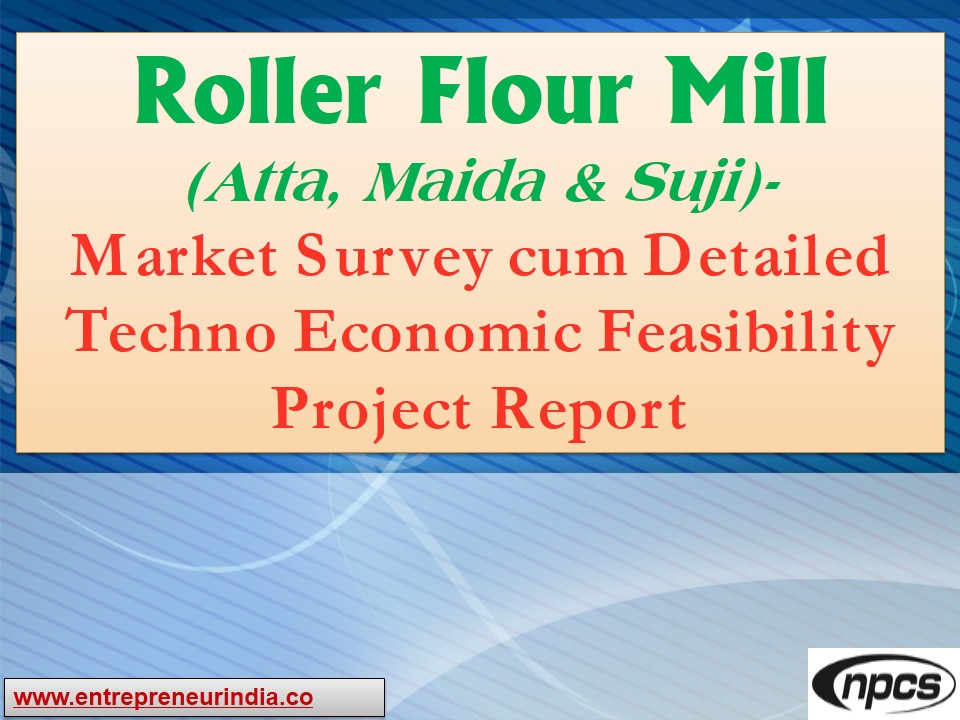
India’s food industry heavily relies on wheat-based products like atta (whole wheat flour), maida (refined flour), and suji (semolina). A roller flour mill plays a crucial role in processing raw wheat into these finished goods. As the demand for packaged flour products continues to grow, establishing a roller flour mill is becoming a lucrative business opportunity for entrepreneurs and investors.
See Also : NPCS Nov 2015
Understanding the Roller Flour Mill Process
A roller flour mill is a modern mechanical setup used to grind wheat into various forms such as atta, maida, and suji. Unlike traditional stone mills, this plant uses cylindrical rollers to crush and separate different parts of the grain. The end products are sorted based on texture and quality. This process ensures uniformity, hygiene, and high productivity.
Importance of Wheat Cleaning
The first step in any roller flour mill is cleaning the raw wheat. Cleaning removes stones, dust, straw, and other foreign materials. Clean wheat enhances the life of machinery and produces higher quality output. Modern cleaning equipment includes magnetic separators, aspirators, scourers, and destoners. This stage is critical for both food safety and machinery durability.
Conditioning and Tempering
After cleaning, the wheat is tempered by adding water to toughen the bran and soften the endosperm. This step makes separation easier in the roller mill. Proper conditioning improves flour yield and helps in getting finer maida and suji. This phase usually requires 6–24 hours of resting time depending on wheat type and moisture content.
Milling Process in a Roller Flour Mill
The core operation begins with the wheat being passed through multiple roller mills and sifters. Each roller crushes and grinds the wheat further, separating the flour from the bran and germ. Here’s a basic flow:
-
Break Rollers: These break open the wheat kernel and separate large bran.
-
Reduction Rollers: These grind the semolina into finer flour.
-
Purifiers: These remove bran particles using airflow and sieves.
After this, flour is categorized into atta, maida, and suji based on its texture and particle size. The roller flour mill ensures minimal manual handling, increasing both speed and hygiene.
Storage and Packaging
The final products must be stored in moisture-controlled silos or bags. Automated packing machines fill pre-weighed quantities into retail or wholesale bags. Packing ensures freshness, improves shelf life, and builds brand identity. Attractive packaging with nutritional information also helps in consumer trust.
Capital Requirement for a Roller Flour Mill
Setting up a small to medium-scale roller flour mill plant requires a moderate investment. The cost depends on production capacity, automation level, and land availability. Here’s an approximate cost breakdown for a 10-ton per day mill:
-
Land & Building: ?20–30 lakhs
-
Machinery & Equipment: ?25–40 lakhs
-
Installation & Utilities: ?10–15 lakhs
-
Working Capital: ?10–20 lakhs
-
Miscellaneous Costs: ?5–10 lakhs
A fully automated setup might cost more but requires less manual labor. Investors can choose modular plants and scale up later.
Choosing the Right Location
Proximity to raw material sources, market access, and transportation are key factors. Ideally, the roller flour mill should be near wheat-producing regions or wholesale mandis. Locations with good road connectivity reduce transportation costs. A clean and hygienic environment also adds value to food-grade processing units.
Raw Material and Procurement
Wheat is the primary input. Quality directly affects the finished product. Entrepreneurs can tie up with local farmers, cooperatives, or wholesale traders. Seasonal price fluctuations in wheat must be considered while planning procurement. Some mills also store wheat in bulk during harvest season to maintain year-round operations.
Quality Control and Compliance
Food processing units must follow FSSAI norms, maintain hygiene standards, and test for microbial contamination. A good roller flour mill uses in-house labs for flour testing (color, fineness, moisture, gluten, etc.). Government certifications and ISO standards add credibility and support sales in institutional markets.
Market Demand for Atta, Maida & Suji
The demand for packaged atta has surged due to changing lifestyles and health awareness. Maida is widely used in bakeries, biscuit manufacturing, and processed food industries. Suji is a staple for breakfast items like upma, halwa, and idlis.
Retail, HORECA (Hotels, Restaurants, and Caterers), and export markets offer vast sales potential. Building a distribution network, supplying to supermarkets, and exploring tie-ups with bakeries are great strategies. Branding and online sales platforms also increase visibility and customer base.
Profitability & Returns
Profit margins in this sector range between 10–20% based on scale and efficiency. Bulk sales to institutional buyers bring better margins. Value-added products like multigrain flour, fortified atta, and gluten-free variants can further boost profitability. Recovery rate of flour from wheat is generally around 72–75%, with by-products like bran being sold as cattle feed.
A well-managed roller flour mill can break even within 2–3 years. Proper planning, cost control, and marketing strategy are vital for success.
Key Licenses and Registrations
To start a roller flour mill legally, the following licenses and registrations are needed:
-
Company Registration (Private Ltd or LLP)
-
FSSAI Food License
-
Factory License
-
GST Registration
-
Pollution Control Board NOC
-
Fire and Safety Certificate
-
Trademark for branding (optional but advisable)
Getting all licenses in place ensures hassle-free operations and builds trust with partners and consumers.
Challenges and Risk Factors
Like any business, the roller flour mill sector has its risks. Here are some common challenges:
-
Volatile wheat prices
-
High competition in branded flour segment
-
Machinery wear and tear
-
Seasonal demand fluctuations
-
Transportation and logistics issues
However, with proper storage, automation, and supplier relationships, these risks can be mitigated. Timely maintenance and skilled staff further improve productivity.
Technology and Automation
Modern flour mills use programmable logic controllers (PLC), pneumatic conveying systems, and automatic packing lines. Automation reduces human errors, enhances efficiency, and maintains hygiene. Investing in upgraded technology gives a competitive edge in the market. Digitization also helps in monitoring real-time data and managing supply chains effectively.
Sustainability and Waste Management
Wheat bran, a by-product of the milling process, is a valuable cattle feed ingredient. Water used in conditioning can be recycled. Mills can adopt energy-efficient motors and dust-free mechanisms to reduce environmental impact. Solar energy usage in plant operations is also gaining popularity among green businesses.
See Also : NPCS Sep 2015
Conclusion
Setting up a roller flour mill for atta, maida, and suji production is a promising venture in India’s evolving food sector. With rising health consciousness and demand for quality flour, the market offers consistent growth. A well-located, efficiently run plant with quality output and strategic marketing can ensure long-term success. By following proper procedures, investing in technology, and understanding market trends, entrepreneurs can build a profitable flour milling business that serves households, food industries, and export markets alike.





